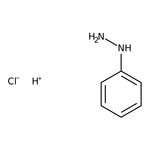Search Thermo Fisher Scientific
Phénylhydrazine, 97 %, Thermo Scientific Chemicals



Phénylhydrazine, 97 %, Thermo Scientific Chemicals
Identifiants chimiques
Spécifications
Description
This Thermo Scientific Chemicals brand product was originally part of the Alfa Aesar product portfolio. Some documentation and label information may refer to the legacy brand. The original Alfa Aesar product / item code or SKU reference has not changed as a part of the brand transition to Thermo Scientific Chemicals.
La phénylhydrazine est impliquée dans la synthèse d’indoles de Fischer pour la préparation d’indoles, qui trouvent une application comme agents intermédiaires dans les produits pharmaceutiques, notamment pour la tryptamine employée comme médicament. On l’utilise en chimie analytique pour différencier et séparer les sucres en formant des phényhydrazones. Il est utilisé comme réactif de protection N et pour le clivage du groupe phtaloyle.
Solubilité
Soluble dans les acides dilués.
Remarques
Sensible à l’air et à la lumière. Gardez le récipient hermétiquement fermé dans un endroit sec et bien ventilé. Incompatible avec les agents oxydants.
Figures
Documentation et téléchargements
Certificats
Foire aux questions (FAQ)
Citations et références
Sécurité et manipulation
Classification of the substance or mixture
CLP classification - Regulation(EC) No 1272/2008
Label Elements
Signal Word
Danger
Hazard Statements
H301 + H311 + H331 - Toxic if swallowed, in contact with skin or if inhaled
H315 - Causes skin irritation
H317 - May cause an allergic skin reaction
H319 - Causes serious eye irritation
H341 - Suspected of causing genetic defects
H350 - May cause cancer
H372 - Causes damage to organs through prolonged or repeated exposure
H400 - Very toxic to aquatic life
EU Specific Hazard Statements
Combustible liquid
Precautionary Statements
P273 - Avoid release to the environment
P280 - Wear protective gloves/protective clothing/eye protection/face protection
P301 + P310 - IF SWALLOWED: Immediately call a POISON CENTER or doctor/physician
P302 + P352 - IF ON SKIN: Wash with plenty of soap and water
P304 + P340 - IF INHALED: Remove person to fresh air and keep comfortable for breathing
P305 + P351 + P338 - IF IN EYES: Rinse cautiously with water for several minutes. Remove contact lenses, if present and easy to do. Continue rinsing
P311 - Call a POISON CENTER or doctor/physician
Additional EU labelling
Restricted to professional users